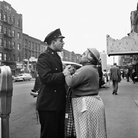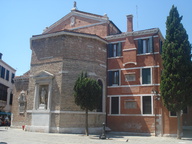Giorgio de Chirico. Major Works from the Collection of Francesco Federico Cerruti

© Giorgio de Chirico, Composizione metafisica (Muse metafisiche) (Metaphysical Composition – Metaphysical Muses), 1918. Collezione Fondazione Francesco Federico Cerruti per l’Arte, long-term loan to Castello di Rivoli Museo d’Arte Contemporanea, Rivoli | Giorgio de Chirico, Composizione metafisica (Muse metafisiche) (Metaphysical Composition – Metaphysical Muses), 1918. Collezione Fondazione Francesco Federico Cerruti per l’Arte, long-term loan to Castello di Rivoli Museo d’Arte Contemporanea, Rivoli
From 06 Marzo 2018 to 04 Novembre 2018
Rivoli | Turin
Place: Castello di Rivoli – Museo d'Arte Contemporanea
Address: piazza Mafalda di Savoia
Telefono per informazioni: +39 011 9565222
E-Mail info: info@castellodirivoli.org
Official site: http://https://www.castellodirivoli.org
Giorgio de Chirico was born in Volos, Greece, in 1888, to Italian parents – his father was a civil engineer building the new railway lines in Greece. He lived in Athens, Munich, Milan, Florence, Paris, Ferrara, New York, and Rome, where he died in 1978. De Chirico is among the most important artists of the twentieth century. After studying at the Athens Polytechnic and at the Academy of Fine Arts in Munich, where he was influenced by the symbolist painting of Arnold Böcklin and the philosophical thought of Arthur Schopenhauer and Friedrich Nietzsche, de Chirico arrived in Italy in 1909.
In 1911, he spent a few days in Turin where the long shadows of the afternoon and the grid of streets, squares and arcaded galleries gave him the impression, as he wrote, that “the city was built for philosophical dissertations.”
The pioneer of an art in which the intellect dominates emotion and, with visionary originality, connects the philosophy of mythological Greece to the icy classicism of Nordic thought, de Chirico is the originator of metaphysical painting, whose enigmatic images, through a style characterized by sharp shadows and flat colors, refer to the suspension of time, immobility, the fragility of the consciousness, the inexpressible and the loss that are the grammar of dreams. This original style is the complex result of the profound philosophical, literary and figurative culture of the artist.
In Paris, de Chirico’s metaphysical canvases proved popular with the Surrealists, but when in the 1920s he focused his interests on painting technique and the Old Masters in Rome, in particular mythological subjects and landscapes, he was rejected by the avant-garde art world. Disregarding the criticism of his former admirers, the artist developed a growing interest in the theme of metamorphosis in the ancient world, for those enigmatic refractions of meaning that, before dissolving into nothing, suggest aspects of existence.
The exhibition Giorgio de Chirico. Major Works from the Collection of Francesco Federico Cerruti, features for the first time at the Castello di Rivoli, a group of important early works by Giorgio de Chirico from the collection of Francesco Federico Cerruti, offering public works which until now have remained hidden away in the private collection of Villa Cerruti in Rivoli. This residence was built by Cerruti, a Turin entrepreneur and industrialist, in the 1960s to house his private collection. According to de Chirico himself, Turin, the place where Nietzsche’s madness exploded, is among the Italian cities that inspired the first metaphysical paintings and their melancholic atmospheres. Featuring works ranging from 1916 to 1927, the exhibition at Castello di Rivoli presents eight important paintings by the pioneer of metaphysical art. Offering a glimpse of the metamorphic capacity of de Chirico’s genius, this exhibition investigates his intellectual heritage by showing his paintings in connection with some of the major contemporary artworks of Castello di Rivoli’s permanent collection, such as installations by Giulio Paolini, Michelangelo Pistoletto and Maurizio Cattelan.
An artist whose personal memories intertwined with classical myths and philosophy, de Chirico in his continuous research – which included the freedom to quote himself and not to stop at a single style, as well as poetry and novel writing – embraced many artistic metamorphoses to respond to the claims of modern progress, resisting its rationality and fascination for technology.
In keeping with the spirit that characterizes the Cerruti collection and its eclectic vision, which ranges from medieval paintings with gold leaf backgrounds to contemporary art, Giorgio de Chirico. Major Works from the Collection of Francesco Federico Cerruti proposes a brand-new journey through time, establishing a link between the works of de Chirico and some of the key pieces of contemporary art in the museum’s permanent collection. Set within the baroque castle, where the past continuously renews its encounter with the present, the exhibition comprises a series of dialogues between paintings by de Chirico and the works of contemporary artists.
Carolyn Christov-Bakargiev states: “In de Chirico, the rediscovery of classical mythology does not unfold as it did in the Renaissance in order to reconstruct a story of the past, but instead to escape history, the same history that has led us from the Renaissance to that dangerous and uncontrollable modern acceleration that has continued right up to the present day. De Chirico is Nietzschean, anti-modern and against historicism. By renewing the concept of circular time, the artist looks back to mythology and the pervasiveness of the concept of metamorphosis that characterizes it.”
In 1911, he spent a few days in Turin where the long shadows of the afternoon and the grid of streets, squares and arcaded galleries gave him the impression, as he wrote, that “the city was built for philosophical dissertations.”
The pioneer of an art in which the intellect dominates emotion and, with visionary originality, connects the philosophy of mythological Greece to the icy classicism of Nordic thought, de Chirico is the originator of metaphysical painting, whose enigmatic images, through a style characterized by sharp shadows and flat colors, refer to the suspension of time, immobility, the fragility of the consciousness, the inexpressible and the loss that are the grammar of dreams. This original style is the complex result of the profound philosophical, literary and figurative culture of the artist.
In Paris, de Chirico’s metaphysical canvases proved popular with the Surrealists, but when in the 1920s he focused his interests on painting technique and the Old Masters in Rome, in particular mythological subjects and landscapes, he was rejected by the avant-garde art world. Disregarding the criticism of his former admirers, the artist developed a growing interest in the theme of metamorphosis in the ancient world, for those enigmatic refractions of meaning that, before dissolving into nothing, suggest aspects of existence.
The exhibition Giorgio de Chirico. Major Works from the Collection of Francesco Federico Cerruti, features for the first time at the Castello di Rivoli, a group of important early works by Giorgio de Chirico from the collection of Francesco Federico Cerruti, offering public works which until now have remained hidden away in the private collection of Villa Cerruti in Rivoli. This residence was built by Cerruti, a Turin entrepreneur and industrialist, in the 1960s to house his private collection. According to de Chirico himself, Turin, the place where Nietzsche’s madness exploded, is among the Italian cities that inspired the first metaphysical paintings and their melancholic atmospheres. Featuring works ranging from 1916 to 1927, the exhibition at Castello di Rivoli presents eight important paintings by the pioneer of metaphysical art. Offering a glimpse of the metamorphic capacity of de Chirico’s genius, this exhibition investigates his intellectual heritage by showing his paintings in connection with some of the major contemporary artworks of Castello di Rivoli’s permanent collection, such as installations by Giulio Paolini, Michelangelo Pistoletto and Maurizio Cattelan.
An artist whose personal memories intertwined with classical myths and philosophy, de Chirico in his continuous research – which included the freedom to quote himself and not to stop at a single style, as well as poetry and novel writing – embraced many artistic metamorphoses to respond to the claims of modern progress, resisting its rationality and fascination for technology.
In keeping with the spirit that characterizes the Cerruti collection and its eclectic vision, which ranges from medieval paintings with gold leaf backgrounds to contemporary art, Giorgio de Chirico. Major Works from the Collection of Francesco Federico Cerruti proposes a brand-new journey through time, establishing a link between the works of de Chirico and some of the key pieces of contemporary art in the museum’s permanent collection. Set within the baroque castle, where the past continuously renews its encounter with the present, the exhibition comprises a series of dialogues between paintings by de Chirico and the works of contemporary artists.
Carolyn Christov-Bakargiev states: “In de Chirico, the rediscovery of classical mythology does not unfold as it did in the Renaissance in order to reconstruct a story of the past, but instead to escape history, the same history that has led us from the Renaissance to that dangerous and uncontrollable modern acceleration that has continued right up to the present day. De Chirico is Nietzschean, anti-modern and against historicism. By renewing the concept of circular time, the artist looks back to mythology and the pervasiveness of the concept of metamorphosis that characterizes it.”
SCARICA IL COMUNICATO IN PDF
COMMENTI

-
 Dal 25 aprile 2025 al 28 settembre 2025
Padova | Centro Alinate San Gaetano
Dal 25 aprile 2025 al 28 settembre 2025
Padova | Centro Alinate San Gaetano
-
 Dal 24 aprile 2025 al 08 giugno 2025
Reggio nell'Emilia | Sedi varie
Dal 24 aprile 2025 al 08 giugno 2025
Reggio nell'Emilia | Sedi varie
-
 Dal 19 aprile 2025 al 12 ottobre 2025
Jesolo | JMuseo
Dal 19 aprile 2025 al 12 ottobre 2025
Jesolo | JMuseo
-
 Dal 19 aprile 2025 al 05 ottobre 2025
Riccione | Villa Mussolini
Dal 19 aprile 2025 al 05 ottobre 2025
Riccione | Villa Mussolini
-
 Dal 17 aprile 2025 al 14 settembre 2025
Roma | Museo Carlo Bilotti Aranciera di Villa Borghese
Dal 17 aprile 2025 al 14 settembre 2025
Roma | Museo Carlo Bilotti Aranciera di Villa Borghese
-
 Dal 17 aprile 2025 al 06 luglio 2025
Perugia | Palazzo della Penna - Centro per le Arti Contemporanee
Dal 17 aprile 2025 al 06 luglio 2025
Perugia | Palazzo della Penna - Centro per le Arti Contemporanee


